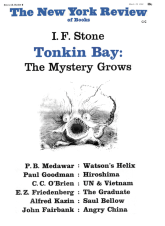On May 30, 1953 James Watson and Francis Crick published in Nature a correct interpretation of the crystalline structure of deoxyribonucleic acid, DNA. It was a great discovery, one which went far beyond merely spelling out the spatial design of a large, complicated, and important molecule. It explained how that molecule could serve genetic purposes—that is to say, how DNA, within the framework of a single common structure, could exist in forms various enough to encode the messages of heredity. It explained how DNA could be stable in a crystalline sense and yet allow for mutability. Above all it explained in principle, at a molecular level, how DNA undergoes its primordial act of reproduction, the making of more DNA exactly like itself. The great thing about their discovery was its completeness, its air of finality. If Watson and Crick had been seen groping toward an answer; if they had published a partly right solution and had been obliged to follow it up with corrections and glosses, some of them made by other people; if the solution had come out piecemeal instead of in a blaze of understanding: then it would still have been a great episode in biological history, but something more in the common run of things; something splendidly well done, but not done in the grand romantic manner.
The work that ended by making biological sense of the nucleic acids began forty years ago in the shabby laboratories of the Ministry of Health in London. In 1928 Dr. Fred Griffith, one of the Ministry’s Medical Officers, published in the Journal of Hygiene a paper describing strange observations on the behavior of pneumococci—behavior which suggested that they could undergo something akin to a transmutation of bacterial species. The pneumococci exist in a variety of genetically different “types,” distinguished one from another by the chemical make-up of their outer sheaths. Griffith injected into mice a mixture of dead pneumococcal cells of one type and living cells of another type, and in due course he recovered living cells of the type that distinguished the dead cells in the original mixture. On the face of it, he had observed a genetic transformation. There was no good reason to question the results of the experiment. Griffith was a well-known and highly expert bacteriologist whose whole professional life had been devoted to describing and defining the variant forms of bacteria, and his experiments (which forestalled the more obvious objections to the meaning he read into them) were straightforward and convincing. Griffith, above all an epidemiologist, did not follow up his work on pneumococcal transformation; nor did he witness its apotheosis, for in 1941 a bomb fell in Enders Street which blew up the Ministry’s laboratory while he and his close colleague William Scott were working in it.
The analysis of pneumococcal transformations was carried forward by Martin Dawson and Richard Sia in Columbia University and by Lionel Alloway at the Rockefeller Institute. Between them they showed that the transformation could occur during cultivation outside the body, and that the agent responsible for the transformation could pass through a filter fine enough to hold back the bacteria themselves. These experiments were of great interest to bacteriologists because they gave a new insight into matters having to do with the ups and downs of virulence; but most biologists and geneticists were completely unaware that they were in progress. The dark ages of DNA came to an end in 1944 with the publication from the Rockefeller Institute of a paper by Oswald Avery and his young colleagues, Colin MacLeod and Maclyn McCarty, which gave very good reasons for supposing that the transforming agent was “a highly polymerized and viscous form of sodium desoxyribonucleate.” This interpretation aroused much resentment, for many scientists unconsciously deplore the resolution of mysteries they have grown up with and have therefore come to love. It nevertheless withstood all efforts to unseat it. Geneticists marveled at its significance, for the agent that brought about the transformation could be thought of as a naked gene. So very probably the genes were not proteins after all, and the nucleic acids themselves could no longer be thought of as a sort of skeletal material for the chromosomes.
THE NEW CONCEPTION was full of difficulties, the most serious being that (compared with the baroque profusion of different kinds of proteins) the nucleic acids seemed too simple in makeup and too little variegated to fulfill a genetic function. These doubts were set at rest by Crick and Watson: the combinatorial variety of the four different bases that enter into the make-up of DNA is more than enough to specify or code for the twenty different kinds of amino acids of which proteins are compounded; more than enough, indeed, to convey the detailed genetic message by which one generation of organisms specifies the inborn constitution of the next. Thanks to the work of Crick and half a dozen others, the form of the genetic code, the scheme of signaling, has now been clarified, and, thanks to work to which Watson has made important contributions, the mechanism by which the genetic message is mapped into the structure of a protein is now in outline understood.
Advertisement
This Issue
March 28, 1968





